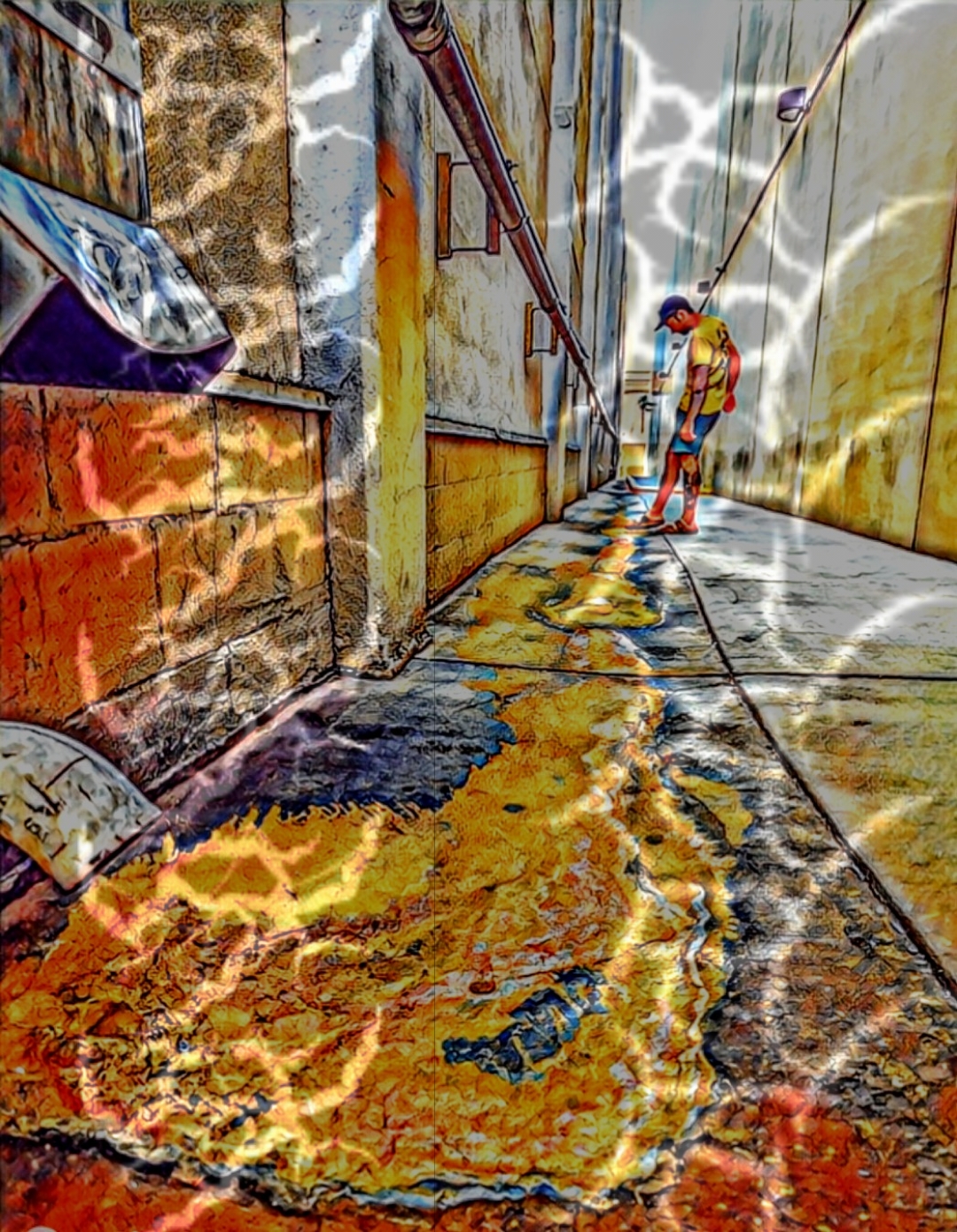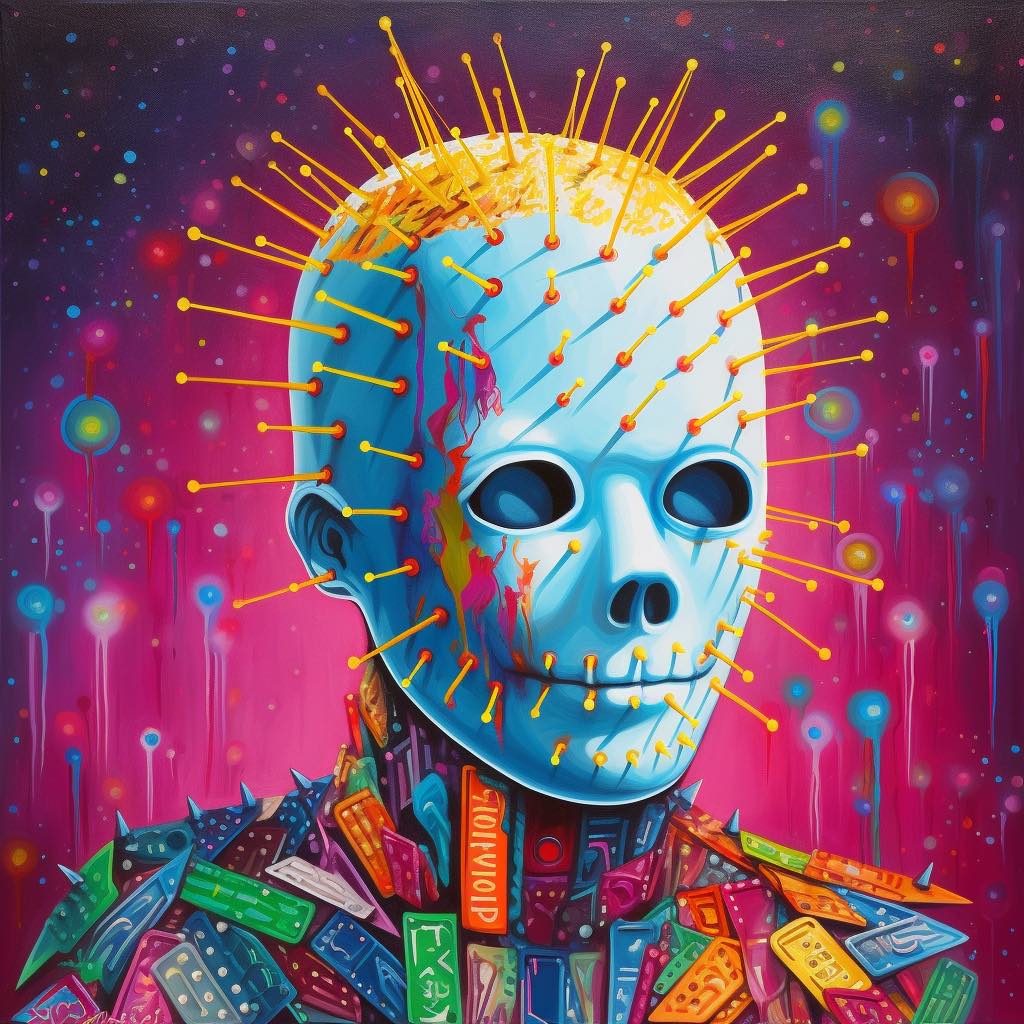IN THIS ISSUE
Realm of Tread
Danny Meyer
xasopheno •
xasopheno •
weresocool.org
Click Here
The game is available on iOS and can be found. Click the link to download. It costs 29¢.
Turn steps into cosmic quests, collect captivating cards from another universe. Discover 400+ unique designs. Begin your health and cosmic journey now.
Warning: Highly enjoyable. Be careful!
Cosmic Horror & Sweet Lovers Love
DJ Koyaanisqatsi & MC Nothing
much_ladue_about_nothing •
onkosonkosonkos
1. Cosmic Horror

2. Sweet Lovers Love (Feat. DJ Choice Paralysis)

Notes on Hellraiser (Part 1)
Devin
geocities • bandcamp

This year for October, I decided to do a deep dive into the Hellraiser franchise. I'd only ever seen the first movie, and as it turns out, there's a ton of material: 11 movies (including the 2022 reboot), a couple of books, dozens of comics, and a fascinating pile of spinoffs and apocrypha. Among the big-name '80s slasher franchises (Freddy, Jason, Michael, etc), Hellraiser is unique in two main respects: First, it's British; Second, its originator Clive Barker is gay and had been comfortably out for some time when he originated the material. Further, it's a deeply heterogeneous franchise: Each movie beyond the 4th is essentially stand-alone, with the only constants being the presence of the puzzle box ("The Lament Configuration") and Pinhead guys ("The Cenobites"); The main comic series essentially operates in its own narrative universe and involves detailed lore which is freely ignored in other media.
This overview will involve spoilers, so if you've never seen any of these movies and want to watch one or two before you go down this rabbit hole, here's my recommendation: Start with the first movie (1987) or the reboot (2022). The original movie is wonderfully compact and still conceptually potent. If you prefer your horror more prestige-y, the reboot is great. It updates in all the right places, stays true to the central ideas, and while a bit long for my taste, covers most of the ground in the first two original movies.
The Setup
Clive Barker started in theater in the late '60s, performing and writing plays while occasional picking up escort work to make ends meet. In the early '80s, he was regularly publishing horror short stories, and tried his hand at screenplay adaptations; Two of these were produced (Underworld and Rawhead Rex), but he was unhappy the directors' handling of the material. With his foot now in the door, he set about writing something he could pitch to studios as a writer-director.
The resulting novella, The Hellbound Heart, is great; It's essentially what you see in the first movie with only a few minor revisions. (The big one is Kirsty, who in the novel is Larry's friend rather than his daughter from an earlier marriage. Some Britishisms were eliminated for pan-Anglo audiences.) The book's description of the Cenobites is captivating, and this is one thing the 2022 reboot absolutely nails: Pinhead is essentially gender-neutral, while the Cenobites generally are described as more — (how to put this?) — romantic than they appear in the original film. Their appearance, for example, is accompanied by the scent of vanilla. Another notable section is Frank's description of his experience in the hands of the Cenobites, which involves a timescale and supra-physicality ill-suited to filmic translation.
The Hellbound Heart and Hellraiser are significantly more concerned with sexual desire and power exchange than the other '80s slasher franchises, which tend instead to focus on sexual trauma or (loosely) ethics. Rather than the appearance of lurking killer out for revenge, Hellraiser's plot is instigated by a hedonist (Frank) whose pleasure-seeking takes him too far, and furthered by his brother's wife (Julia), whose memories of the raw intensity of their short-lived affair has slowly poisoned her marriage. While Kirsty is ostensibly the protagonist, the dynamic between Julia, Frank, and the Cenobites are the beating heart of the film. The decision to display the gore so openly adds a fascinating component to their dynamic in the films; Confronted with Frank's skinless, dripping mess of a resurrected corpse, we watch Julia's shock and disgust transmute into something else -- a willingness to endure the horrific to fulfill her desires. The early scenes in Hellraiser II, where Dr. Channard is seduced by a resurrected Julia, replay this dynamic with probably the most refined acting in the franchise.
In any event, god bless producer Christopher Figg for throwing $900k at this movie, which takes place mostly inside a small cottage and involves people being literally flayed alive. Charmingly cognizant of his directorial inexperience, Barker often deferred to his experienced crew members, leading to some winning experimentation with lighting, blocking, and FX. One fascinating tangent is costume designer Jane Wildgoose, a fashion historian who created the Cenobite's iconic ensembles as a mix of the traditional Catholic cassock and butchering aprons, based on Barker's request for "repulsive glamour." She's currently a weirdo academic, her website is full of oddities; here's a film writer's deep dive into the costuming choices.)
Perhaps assuming this would be a one-and-done, Barker made the retrospectively poor choice to cede the movie rights to the characters to the studio. So when the film recouped expenses in two weeks and grossed $14M on a five-week-average theatrical run, the table was set for an endless parade of sequels with a revolving door of writers and directors, who can elect to work with Barker or not. But I would actually argue this separation is conceptually preferable: Contiguous film series involving supernatural elements often fall victim to the plot-genercization of scope creep. In the first movie, we're saving our friends; By the third, we're saving the world. Creating this separation between film, book, and comic content allows each media to independently explore different ideas, angles, film-making and art styles, narrative scopes, etc.
I emphasize conceptually here, because unfortunately the movies have a well-earned reputation for going downhill swiftly, beginning with the big-budget misfire of the 4th (Bloodline). By the time we get to sequels 7 and 8, we're talking direct-to-video schlock; while 9 and 10 were produced for $300k apiece solely so the studio wouldn't lose ownership of the IP during the drawn-out process of developing the reboot. Having now walked this road, I can tell you a full traversal of the movies is not for the faint of heart nor the refined of taste.
As for the comics -- I'm honestly not the target audience here: I didn't grow up on the form and don't have a particular affinity for its aesthetics, narrative style, or tropes. (I do read them occasionally, though: Brown's Andre the Giant is probably my favorite.) They are deeply concerned with lore and exposition, and in later volumes indulge in massive scope expansion; The armies of hell battling it out for the fate of the universe, that sort of thing. One real advantage of the comics is they are unrestrained by budget or physical laws when depicting gore -- if this is your cup of tea, saddle up!
Because there's so much Hellraiser material and its quality is so varied, you can find plenty of fandom guides and (in particular) ranking lists for the movies. I'm going to proceed in less formal way, basically taking the franchises "in chunks," occasionally detouring to highlight some inter-entry commonalities or contrasts I found notable.
Theater Work
A bit like its British horror predecessor Alien, Hellraiser is extremely compact and operates a bit like a 19th c. haunted house tale or (naturally, given Barker's background) a theater piece. The action is mostly confined to a small attic, with occasional detours into the Cenobites' realm ("The Labyrinth"), and consists mainly of characters negotiating the ever-descending depths to which they'll sink to get what they want or save their own necks.
Julia, Julia, Julia! Theater powerhouse Clare Higgins turns in a captivating performance here, rounding out a lesser-seen character type in 80s horror: A middle-aged woman neither imploding into psychosis nor fiercely protecting her children. Instead, she's slowly coming to grips with the extent of her compromises for stable domesticity and unexpectedly being offered a way out. (This is a weird comparison, but the general setup is similar in some ways to Bridges of Madison County.) Where the novella explicitizes her struggles with civic dislocation and depression, Higgins sublimates these narrative threads into pained faux-smiles and distracted flicks of a cigarette.
Aside from Barker's free hand with the crew, another happy accident is the movie's soundtrack, for which Barker had initially tapped the experimental band Coil. The producers instead insisted on a more formal direction, hiring journeyman film composer Christopher Young. The later-released Coil demos indicate they were going in a John Carpenter-esq direction, whereas Young's score draws from Golden-Age Hollywood's aesthetics and cross-talk with early-20th c. orchestral harmonic languages (think: Miklos Rozsa's thicc film noir scores). This unusually lush treatment for a slasher film adds an unexpected weight to moments like Julia's reminiscences, Frank's resurrection, and the murder spree in the attic. Coupled with the movie's theatrical leanings, it sometimes feels like a layer of sickening gore has been transposed onto a 1960s drama.
While Kirsty is ostensibly our protagonist, Hellraiser's story really belongs to Julia and Frank -- Kirsty's moment to shine arrives in Hellraiser II: Hellbound, a direct sequel which picks up with her locked up in the Channard Mental Institute. Kirsty's role in the first movie is mainly reactive: After accidentally summoning the Cenobites, she makes a deal to save herself, offering to return Frank to them. By the end of the movie, she's blood-soaked and victorious, having evaded Pinhead's capture. In Hellbound, she takes the fight to the enemy, blazing a trail through the endless horrors of the Labyrinth.
I have mixed feelings about Hellbound! After the success of the first movie, there was enough coin in the coffers to deliver a true odyssean epic, and you love to see it. But one of the things I truly appreciated about the Cenobites in the novella and first movie is their terrifying otherness, their lack of specificity, their absence of context. Hellbound is all about the lore: Dr. Channard's insatiable thirst for knowledge sets him on a wild Bildungsroman in the Cenobite world. We are introduced to Leviathan, the god of pure darkness watching over the Labyrinth, and we catch glimpses of the eternal horrors awaiting any mortal foolish enough to be ensnared by its temptations.
And here we come to an important division between the parts of the Franchise that Barker is involved with, and the parts which other creators make. Barker brings a deep fascination with existing spiritualist mythologies to the world of Hellraiser. Like the monastic tradition (where the term "Cenobites" comes from), each Cenobite is an individual, but they're operating within various frameworks and hierarchies, some handed down by Leviathan, and some directives from the Hell Priest (ie, Pinhead). Frankly, I'm neither here-nor-there on this rules-and-regulation stuff; and I often think explicitizing it is more trouble than it's worth, because even in the Barker-led parts of the franchise, this lore is often amended, contradicted, or discarded.
Anywho -- if Hellriaser is a tense family drama, Hellbound is a rolicking adventure movie. Kirsty and Trish traipsing around Hell and messing shit up, heck yeah I'm all in!
Comics
This is a good place to split off and discuss the comics. They come in two flavors: Compilations with stand-alone stories by different writers and artists (from Epic and Seraphim), and severnal multi-volume runs which constitute a single contiguous story (from Boom! Studios).
The later pick up with Krisy Cotton after the events of the second movie. Over time, she assembles a rag-tag crew (mercenary, metaphysicist, former CIA spook, etc) dedicated to finding and destroying puzzle boxes as they appear on Earth. Meanwhile, down in the labyrinth, Pinhead is beginning to wonder if his gig is getting a little stale. After much rigamarole, he convinces Kirsty to take over as Hell Priest so he can become mortal once again. This series also loops in the character Harry D'Amour, who, by number of appearances, is perhaps the main human protagonist of the broader Hellraiser franchise. D'Amour is "Philip Marlowe by way of Clive Barker:" a world-weary, wise-cracking, hard-boiled detective with the unfortunate gift of being able to sense and interact with the supernatural -- a truly double-edged sword with the supernatural world of Hellraiser. (D'Amour features in many of Barker's short stories, anthologized in the Books of Blood series, as well as The Scarlet Gospels.)
The Boom! Studios comics' plots often have the flavor of courtly dramas: Plans-within-plans, feints-within-feints, tenuous alliances and double-crossings between friend and foe alike. There's an interesting graphical focus on the Cenobites' procedural minutia... which at times seems surprisingly mutable. The Labyrinth, like Earth, is a apparently deeply messy site of communal engagement, where who shows up matters just as much as (if not more than) how things are supposed to be done. In any event, we eventually find there are actually many different hells; And thus begins the comics' inevitable tumble into save-the-universe scope creep, where the armies of different hells duke it out for both internal dominance and control of the Earth's poor unfortunate souls.
As I mentioned up-top, these kinds of plots just aren't my cup of tea. For my money, the various Epic! compilations and one-offs were _way_ more interesting and enjoyable, traversing far-flung settings and styles like the Wild West in classic pulp offset printing; a 19th c. South American Junta in thick-lined inks; Lepper colonies in pastel guache; A 1950s highschool drama called "Dear Diary"... the sky's the limit! The stories in these compilations run the gamut from edgy teenager nonsense to deeply serious engagements with mental illness; and tend to be refreshingly unconcerned with consistency, focusing instead on the personal, the particular, and the idiosyncratic -- just the way I like it.
Back to the Movies
So here's where things start to go off the rails in movie-land. The 3rd movie (Hell on Earth, 1992) is a big, dumb, goofy-fun horror flick, with some truly iconic early-90s lewks and interior design. (Ocher and teal sponge-painted walls? A spoopy NY night club called "the boiler room" with an attached fine-dining ballroom? Sure! Why not? it's the 90s!) Our protagonist is a TV anchorwoman sick of being underestimated as just another pretty face and ready to break some _real news_. Sold!
The plot is kick-started by the (delightfully slimy) nightclub owner's purchase of a sculpture in which Pinhead is trapped, but the movie eventually takes a hard left into Pinhead's backstory. After his "death" in Hellbound, Pinhead's soul was bifurcated into its orderly Human side and its chaotic Cenobite side; The Human side is trying to reconnect the two and restore balance, while the chaotic is trying instead to, uh, slaughter all of humanity? Frankly, the main problem with this movie is that you could replace the Cenobites with basically any generic supernatural villain and the movie would still play the same; The only solidly Hellraiser-y moments come when Chaotic Pinhead, then trapped inside the sculpture, has to persuade the slimy club owner to bring him some fresh bodies to slaughter.
Hell on Earth jumps the shark in various ways -- Pinhead turns the club's DJ into a deadly CD-slinging Cenobite -- but the 4th movie literally opens on a space station in the year 2127, where a robot solves the puzzle box and gives a "ruh roh!" face before exploding. Welcome to Hellraiser: Bloodline!
Directed by the one-and-only Alan Smithee, Bloodline is a convoluted mess of a movie, the kind of studio-meddling palimpsest only a true connoisseur could love. The root of the problem is that the story's scope is very wide: It's more appropriate for novelization, where dramatic leaps in setting and style are as cheap and easy as ink on the page. In the movies, however, these century-wide jumps necessitate entirely different set designs, lighting styles, costuming, FX, diligent scheduling... the list goes on and on.
Worst of all, the story itself is cool and would make for an excellent non-film adaptation. We begin in Paris, 1796, where toymaker Phillip LeMarchand is commissioned to make a puzzle box of exquisite design and refinement. Its commissioner, an aristocratic occultist, uses it to summon a daemon, Angelique, who eventually kills the aristocrat with the help of his long-suffering assistant (the breakout role for Adam "Cones of Dunshire" Scott). Thereafter, we follow LeMarchand's accursed ~bloodline~ through the generations, as his male descendants, savants all, confront and contain the gnashing chaos of hell with their ingenious designs.
The movie's final edit, interleaves these historical epochs with deeply annoying expo recaps aboard the space station; simultaneously insulting the audience's intelligence and wasting our time. (For the completionists, there exists an assembly-cut version which proceeds linearly thereby eliminating these issues. It was made by director Kevin Yagher just prior to his departure, and is available online.)
Contrary to popular belief, this move did okay at the box office, grossing $9.3M on a $4M budget. Its shortcomings were easily identified by critics, but perhaps more problematically by the franchise's fanbase, who, given the first three movies, probably had higher standards for a horror film than the studio was expecting. In any event, given there was still financial gas left in the tank, another sequel was only a matter of time...
To be continued
Thank you for visiting QUANTITY MAGAZINE!
This thing is run by:
Molly Bolten
Devin Smith
Mark Pascucci-Clifford
If you would like to contribute, email us!!